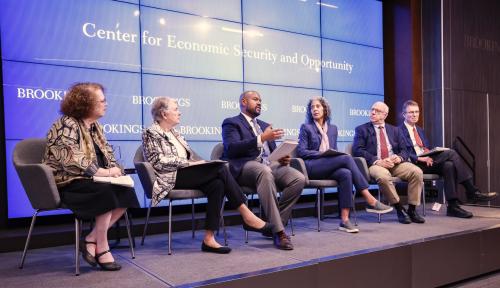The National Journal and The Atlantic just published the second supplement in its “next economy” series entitled: “the geography of opportunity.”
The lead essay chronicles the ongoing “war over the future” between urban gurus Joel Kotkin and Richard Florida: a contest between suburbs and cities, sprawl, and density, Middle America and the coasts, the metropolis and the megaregion.
What to make of all this? Who is right? Who is wrong?
On one level, Kotkin and Florida are still wrestling over traditional urban planning turf, trying to discern housing, transport, and location preferences of a society growing ever more complex with each passing decade. Brookings’ State of Metropolitan America report released earlier this year showed a nation in the throes of demographic transformation, simultaneously growing, aging, diversifying, and splintering along new cultural and educational fault lines. At the same time, the U.S. economy is slowly restructuring in the aftermath of the Great Recession, tilting gradually away from excessive consumption towards more productive activity.
Against this backdrop, it is simple folly to believe that one “American trend” (e.g., Florida’s urban-like density or Kotkin’s suburban-like sprawl) is predetermined by the complicated mix of individual and firm choices, overarching economic and environmental imperatives, varied policy interventions, and ever evolving technological possibilities.
If anything, the development patterns within our metropolitan areas will continue to be as multidimensional as the demographic, economic, and other forces that affect place making. In fact, divisions across cities, suburbs, and other parts of metropolitan areas, in form and social composition, are blurring, as seen with trends as disparate as the suburbanization of poverty and the rise of walkable suburban downtowns and villages. At the same time, divisions among metropolitan areas–in age structure, educational attainment and income–are growing, with both old urban and newer suburban metro areas succeeding (Boston, Dallas) and struggling (Detroit, Bakersfield).
If there is any consistent trend, it is the cementing of the larger metropolis as the new spatial form, seamlessly enveloping cities and suburbs, exurbs and even rural towns (or living) at the periphery.
That leads to the second level of the futurist debate, namely the domestic and global competition and cooperation between metropolitan areas rather than within metropolitan areas.
Here we are in new spatial territory, as a new metropolitan map is emerging that defines not the U.S. but our relationship to the world. Networks form the unifying thread of the new map. American metros relate to each other through complex supply chain networks and migration patterns that are based on the endowed assets, distinctive economic clusters and social/cultural histories of individual metros. Likewise, U.S. metros relate to foreign metros through trading relationships and the exchange of goods, services, people, and goods.
The new map defies our conventional way of thinking about the world. Proximity of place to place (say Cleveland to Pittsburgh) only counts for so much in the new world. The essence of what a place does (i.e., what goods it produces, what services it provides) matters more.
Here the analyses of Kotkin and Florida appear to be either too narrow or too broad. Kotkin’s juxtaposition of favored suburban metros in the heartland with urban metros along the coasts underestimates, if not ignores, the linkages between communities within these disparate spheres. Metros are not islands by themselves; they are part of broader networks domestically and globally, and understanding those networks is one of the essential keys to success in the new global world. Omaha, Nebraska, for example, an iconic heartland metro, specializes in such sectors as insurance, technology, and architecture, meaning that Omaha’s success is directly connected to firms situated and business generated in places like the Bay Area, 1700 miles away.
At the same time, Florida’s focus on megaregions (and the high speed rail that he says should link these places) is overly expansive. It is doubtful whether connecting Cleveland to Chicago is rooted in any economic connections and trading relations that matter today. In a constrained fiscal climate, such cross-metro infrastructure investments will just crowd out the kinds of transformative interventions that are needed within metros (e.g., rightsizing of cities around anchors, multimodal facilities at major logistical hubs, new energy infrastructure).
In the end, Kotkin and Florida, right or wrong, do agree on one central theme: “the power of place.” In a new “Metro Century,” that may be the most important contribution of all.


Commentary
Function, Form, and the Metropolitan Future
September 14, 2010